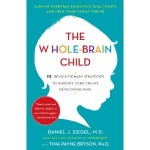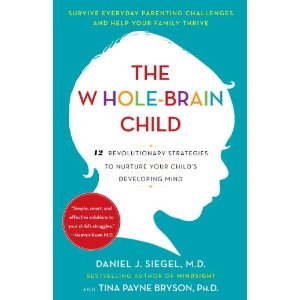 Before you can use Strategy 10 from The Whole-Brain Child, you have to understand what mindsight is. Siegel and Bryson describe mindsight as, “understanding our own mind as well as understanding the mind of another.” They go on to describe our mind:
Before you can use Strategy 10 from The Whole-Brain Child, you have to understand what mindsight is. Siegel and Bryson describe mindsight as, “understanding our own mind as well as understanding the mind of another.” They go on to describe our mind:
“… as a bicycle wheel with a hub at the center and spokes radiating toward the outer rim. The rim represents anything we can pay attention to or become aware of: our thoughts and feelings, our dreams and desires, our memories, our perceptions of the outside world, and the sensations from our body. The hub is the inner place of the mind from which we become aware of all that’s happening around and within us … Our awareness resides in the hub, and from here we can focus on the various points on the rim of our wheel.”
We can have a lot swirling around in our head (the rim), but we learn to focus or not focus (the hub) on specific things. Many of our children haven’t learned this. They are focusing on thoughts, feelings, images that are negative, and they need to learn that they can change what they are focusing on.
Siegel and Bryson suggest teaching your children how to focus on their breath during nervous, anxious or difficult times to calm themselves, so they can change their focus from the rim to their hub. “Even as young as four or five, kids can learn to focus on their breath. A good technique is to have them lie down and place a toy—like a boat—on their stomach. Ask them to focus on the boat, watching it rise and fall as it rides the waves of breath.”
My daughter and I have not been able to recreate the activity of lying down with a toy on her stomach. I do find myself suggesting she take a break, breathe, and focus on what her body is telling her. One weekday morning, Elise knew she had a fun activity that day, yet every encounter we had with her that morning was a blow up. She was stuck in a funk. For example, “Elise, do you want milk or juice?” Her reply, “Fine, I just won’t drink anything! You never get me anything to drink!” It wasn’t really that bad, but you get the idea. After she took a break and focused, she told us that she was worried about the activity; we were able to navigate that issue with her. And she did great the rest of the morning and with the activity—she just needed to realize what she was paying attention to, what was going on in her body and then change it.
Practicing Strategy 10 will help your child get un-stuck and decide how they think and feel. It will take practice for you and your child. And you may not always get it right, but that’s okay—keep trying. Ultimately, by helping your child learn to get un-stuck, to get off the rim and back to their hub, you can help change your child’s brain. As Siegel and Bryson say, “it’s from [the hub] that we make our best decisions; it’s also the part of the brain that allows us to connect deeply to others and to ourselves.”
We want our children to make great decisions in the face of whatever life throws at them. In addition, we want them to connect in healthy relationships. This is why we must help our kids learn mindsight.

